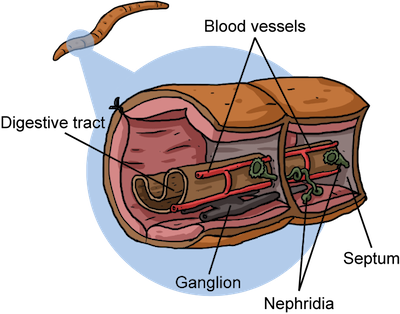What's In a Worm?
Segmented worms like earthworms and leeches are found all over the place—from our compost to under the sea. Annelida means "little rings," which is how these worms look on the outside, like the bendy part of a straw. Annelids are the first branch of the family tree with a segmented body.

The land-dwelling annelids, like earthworms, breathe differently than freshwater and marine annelids. Water-dwelling annelids such as leeches have gills for getting oxygen from the water. The surface of a land-dwelling earthworm is covered with blood vessels that exchange gases with the air via water. This is why earthworms die when stranded on the sidewalk. They dry out and can't breathe.
Annelids can change the shape of each section separately, which helps them move. One section squeezes and then the next to wriggle the worm along. Annelid muscles work against the fluid-filled hydrostatic skeleton. Annelids often have some sort of bristles on the outside of their body called setae, which help them move. Some annelids also have parapodia ("beside feet" or "almost feet"). These are little parts that stick out from each section and act a bit like feet.
Some annelids can also reproduce asexually. In some annelid species, a new animal may bud from a parent or one animal can split into two. Some annelids can also regenerate parts if a segment is broken off. Yes, it's true that earthworms can regenerate, but only from the front half.
Think leeches are disgusting? Well, you're right. But they must be pretty smart, because a leech has 32 brains. Leeches are made up of 32 segments, and each segment gets its very own brain.
A Worm is Just a Bunch of Segments
The coelom of an annelid is divided into sections, separated by walls called septa (or "fence"). Each segment is called a metamere. The digestive system and circulatory system run through the whole length of the animal. The digestive system is one-way, end to end, and is the most complex one we've seen so far, with sections that have unique structures and purposes:- Pharynx (draws in the food)
- Esophagus (leads to the rest of the track)
- Crop (food storage area)
- Gizzard (grinds food up)
- Intestine (further digestion and absorption of food)

The land-dwelling annelids, like earthworms, breathe differently than freshwater and marine annelids. Water-dwelling annelids such as leeches have gills for getting oxygen from the water. The surface of a land-dwelling earthworm is covered with blood vessels that exchange gases with the air via water. This is why earthworms die when stranded on the sidewalk. They dry out and can't breathe.
Annelids can change the shape of each section separately, which helps them move. One section squeezes and then the next to wriggle the worm along. Annelid muscles work against the fluid-filled hydrostatic skeleton. Annelids often have some sort of bristles on the outside of their body called setae, which help them move. Some annelids also have parapodia ("beside feet" or "almost feet"). These are little parts that stick out from each section and act a bit like feet.
Annelid Reproduction
All annelids reproduce sexually, but some have separate sexes while others are hermaphrodites. They also all lay eggs. Life cycles are different, though, between land and marine annelids. (Different adaptations are needed on land than in water and we can see this within a phylum as well as between phyla.) Marine annelids go through two different stages in life: for example, a trochophore floats through the water and then changes into the adult form by adding segments. Land annelids produce young that are little versions of adults.Some annelids can also reproduce asexually. In some annelid species, a new animal may bud from a parent or one animal can split into two. Some annelids can also regenerate parts if a segment is broken off. Yes, it's true that earthworms can regenerate, but only from the front half.
Annelid Classes
Annelid characteristics:- True coelom
- One-way digestive system
- Digestive system with distinct sections that have distinct purposes
- Closed circulation
- Body segmentation, with each called a metamere
- May have parapodia and many have setae (bristles)
- Hydrostatic skeleton
- Polychaeta ("many bristles") are marine worms with parapodia that have separate sexes. Polychaetes go through two life stages, trochophore and adult. This class includes worms that swim, some that crawl on the sea floor and others that dwell in tubes. They are generally carnivorous. Polychaetes can be spectacular, like this Christmas tree worm.
- Oligochaeta ("few bristles") includes earthworms and some aquatic annelids, with no parapodia and few, if any, setae. Earthworms are hermaphrodites and can also reproduce asexually.
- Hirundinea are leeches, living in fresh water. Some eat small invertebrates, but others are the famous blood-sucking parasites. They have no parapodia, but have suckers to attach to prey. They are also hermaphrodites.
Think leeches are disgusting? Well, you're right. But they must be pretty smart, because a leech has 32 brains. Leeches are made up of 32 segments, and each segment gets its very own brain.